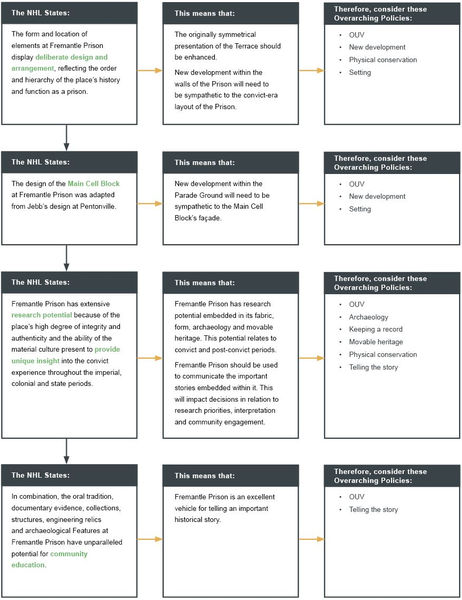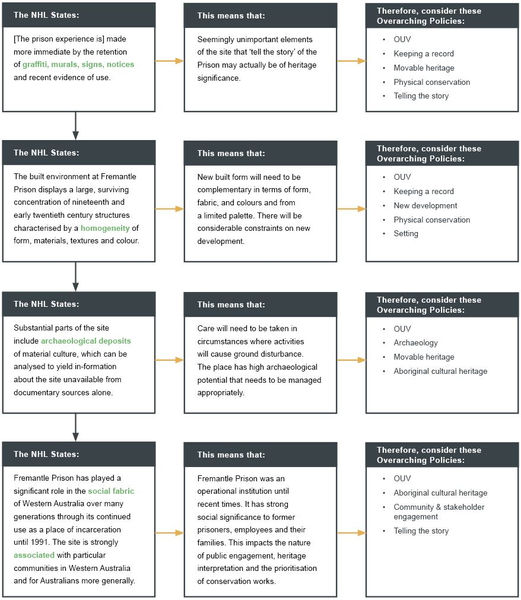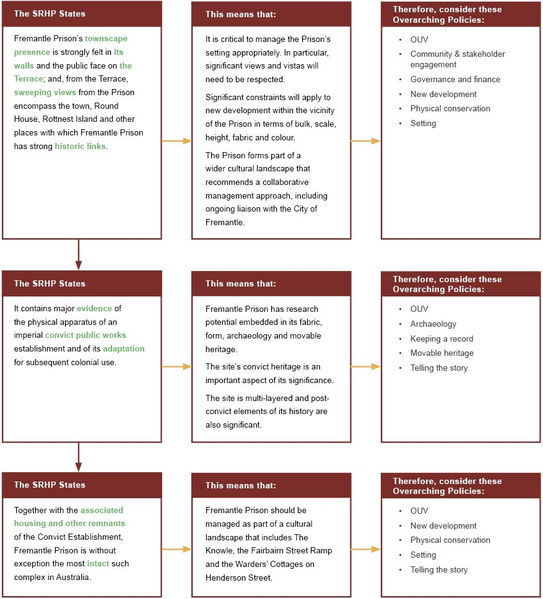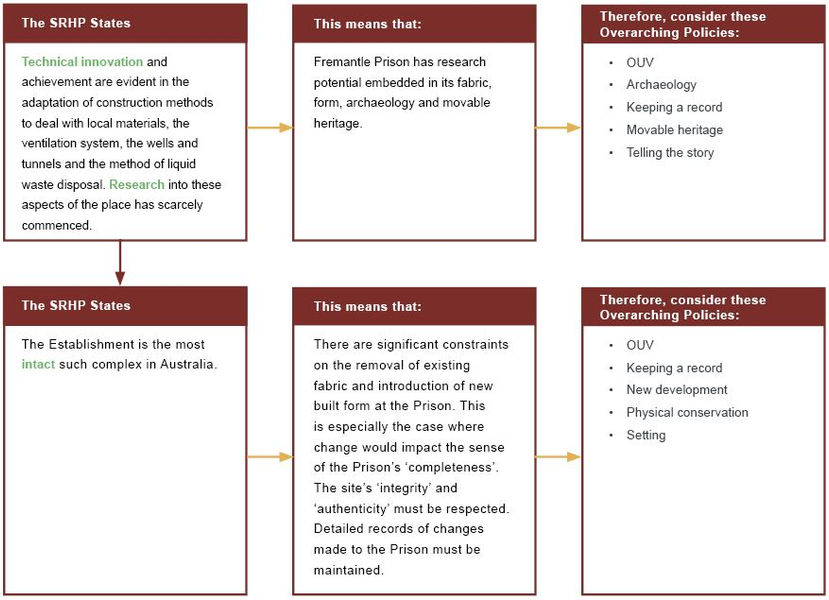
Heritage Status
Listings
The following table summarises the heritage listings relevant to Fremantle Prison.


Figure 7. Detail of Figure 3 above showing the boundaries of the Fremantle Prison World Heritage Listed area (shaded green) and the WHL buffer zone (shaded orange).

Figure 8. Plan showing the boundaries of the Fremantle Prison listed area on the National Heritage List (green hatched area). Note that it captures the Fairbairn Street Ramp and Henderson Street Warders’ Cottages (Source: http://www.environment.gov.au/heritage/places/national/fremantle-Prison).

Figure 9. Plan showing the boundaries of the Fremantle Prison listed area on the WA State Register of Heritage Places. The Henderson Street Warders’ Cottages and The Knowle (not indicated here) are also listed on the SRHP, but not the Fairbairn Street Ramp. (Source: http://inherit.stateheritage.wa.gov.au/Public/Inventory/Details/ca161bd9-4671-41ea-96a0-82ef1918b077).
Assessed Heritage Values and Statement of Significance
Statement of Authencity and Integrity
Fremantle Prison must be managed having regard to its ‘authenticity’. The Operational Guidelines for the Implementation of the World Heritage Convention (2017) defines ‘authenticity’ by reference to how ‘credible or truthful’ the different sources of information about a place’s heritage values are (Article 80). The Operational Guidelines states that (Article 82):
properties may be understood to meet the conditions of authenticity if their cultural values … are truthfully and credibly expressed through a variety of attributes including:
-
form and design
-
materials and substance
-
use and function
-
traditions, techniques and management systems
-
location and setting
-
language, and other forms of intangible heritage
-
spirit and feeling
-
other internal and external factors
Relatedly, the Operational Guidelines defines ‘integrity’ as a ‘measure of the wholeness and intactness’ of a place’s cultural heritage and its attributes (Article 88).
Fremantle Prison was used continuously as a prison from the convict era through to 1991. Since 1991, Fremantle Prison has been carefully conserved to ensure that its fabric is maintained in good condition and inappropriate changes to its form, fabric, setting and evocative character are avoided.
As a result, Fremantle Prison has exceptional integrity and is highly authentic. This is reflected in its inscription on the World Heritage List for its convict era values. To maintain it in this state, the close nexus between the physical condition of its form and fabric, and its heritage values, must be understood and respected. These considerations have informed the policies, principles and actions provided in this HMP.
Co-existing Cultural Values
This HMP is responsive to Article 13 of the Burra Charter, which states:
Co-existence of cultural values should always be recognised, respected and encouraged. This is especially important in cases where they conflict.
In other words, this HMP recognises that Fremantle Prison embodies a range of heritage values at different levels of significance. It envisages that these can usually co-exist, and that it will ordinarily be possible to conserve Fremantle Prison’s OUV without adverse impact
on its National Heritage values and state significance. However, in those circumstances where there is a clear conflict of conservation requirements, the conservation of Fremantle Prison’s OUV will prevail
Fremantle Prison as Part of a Cultural Landscape
This HMP adopts a holistic approach to understanding and managing ‘Fremantle Prison’. It regards the Prison as part of a wider cultural landscape that includes physically disparate but historically and functionally related locations, including the following places from the convict era:
-
Fremantle Prison
-
The Knowle
-
the Warders’ Cottages on
-
Henderson Street
-
the Fairbairn Street Ramp
-
the former Fremantle Lunatic Asylum
-
the Rottnest Island Prison
-
the other convict sites included on the WHL Australian Convict Sites listing
Similarly, Fremantle Prison is located on the eastern edge of the highly significant Fremantle CBD. The Prison and the City of Fremantle comprise two parts of a broader nineteenth and early twentieth century cultural landscape that requires a collaborative approach to management and conservation. Given the Prison’s status on the WHL the management of its OUV will be a preeminent consideration in such a collaborative management approach.
Significance as the Determinant of Management Reponses
Article 6.1 of the Burra Charter describes ‘The Burra Charter Process’. It states:
The cultural significance of a place and other issues affecting its future are best understood by a sequence of collecting and analysing information before making decisions. Understanding cultural significance comes first, then development of policy and finally management of the place in accordance with the policy. This is the Burra Charter Process.
Article 6.2 of the Burra Charter states:
Policy for managing a place must be based on an understanding of its cultural significance.
In other words, the heritage values of a place determine the appropriate management response. Therefore, it is essential that the reasons for a place’s heritage listing are understood.
The policies and actions presented in this HMP derive directly from its assessed levels of significance and its identified heritage values.
Fremantle Prison is inscribed on the WHL for satisfying Criteria (iv) and (vi). Specifically (quoting the WHL Statement of Outstanding Universal Value):
-
Criterion (iv): The Australian convict sites constitute an outstanding example of the way in which conventional forced labour and national prison systems were transformed, in major European nations in the 18th and 19th centuries, into a system of deportation and forced labour forming part of the British Empire’s vast colonial project. They illustrate the variety of the creation of penal colonies to serve the many material needs created by the development of a new territory. They bear witness to a penitentiary system which had many objectives, ranging from severe punishment used as a deterrent to forced labour for men, women and children, and the rehabilitation of the convicts through labour and discipline.
-
Criterion (vi): The transportation of criminals, delinquents, and political prisoners to colonial lands by the great nation states between the 18th and 20th centuries is an important aspect of human history, especially with regard to its penal, political and colonial dimensions. The Australian convict settlements provide a particularly complete example of this history and the associated symbolic values derived from discussions in modern and contemporary European society. They illustrate an active phase in the occupation of colonial lands to the detriment of the Aboriginal peoples, and the process of creating a colonial population of European origin through the dialectic of punishment and transportation followed by forced labour and social rehabilitation to the eventual social integration of convicts as settlers.
In developing management responses to Fremantle Prison’s OUV this HMP has had regard to the following elements of the Statement of Outstanding Universal Value:
-
Although Fremantle Prison embodies a range of heritage values, it has been inscribed on the WHL for its convict-era heritage values not those from later periods of use.
-
Those elements of Fremantle Prison that illustrate convict-era coercion, austerity, isolation and labour are particularly important, as are elements that illustrate the adaptive responses of the convicts.
-
Fremantle Prison was part of a global movement and should be managed having regard to the other Australian convict places included in the serial listing on the WHL.
-
Fremantle Prison played an important role in providing the material needs of the fledgling settlements of Perth and Fremantle. It comprises part of a broader cultural landscape that demands a holistic approach to its management.
-
Fremantle Prison has symbolic value.
-
Managers must be alert to the ways in which form and fabric demonstrate the former convict-era functions.
Section 5 of this HMP includes an Overarching Policy on the Prison’s OUV that responds directly to these matters. However, all of the Overarching Policies ultimately derive from and respond to the Prison’s OUV.
A lengthy Statement of Heritage Values for Fremantle Prison was prepared for its inclusion on the NHL. It is reproduced in full in Appendix A. The Statement of Heritage Values prepared for the NHL has many similarities with the Statement of Outstanding Universal Value presented above.
Fremantle Prison is also listed on the WA Register of Heritage Places, and the full Statement of Significance is included at Appendix A. The Statement of OUV, Statement of Heritage Values from the NHL, and the Statement of Significance from the WA State Register of Heritage Places are mutually supporting and share many features. The state heritage citation also emphasises the historical and social significance of Fremantle Prison and expands on its aesthetic significance with particular implications for new development at or near the Prison.
In the following two tables, selected extracts have been reproduced from the NHL Statement of Heritage Values and the SRHP Statement of Significance. They have been presented in a ‘chain of reasoning’ that links those extracts with the management implications that they gave rise to and the policy responses in this HMP. Key words and phrases that have impacted policy development have been highlighted.
Where the Statement of Significance repeats certain aspects of Fremantle Prison’s significance, they are deliberately repeated below as a way of emphasising these crucial matters in management terms.










